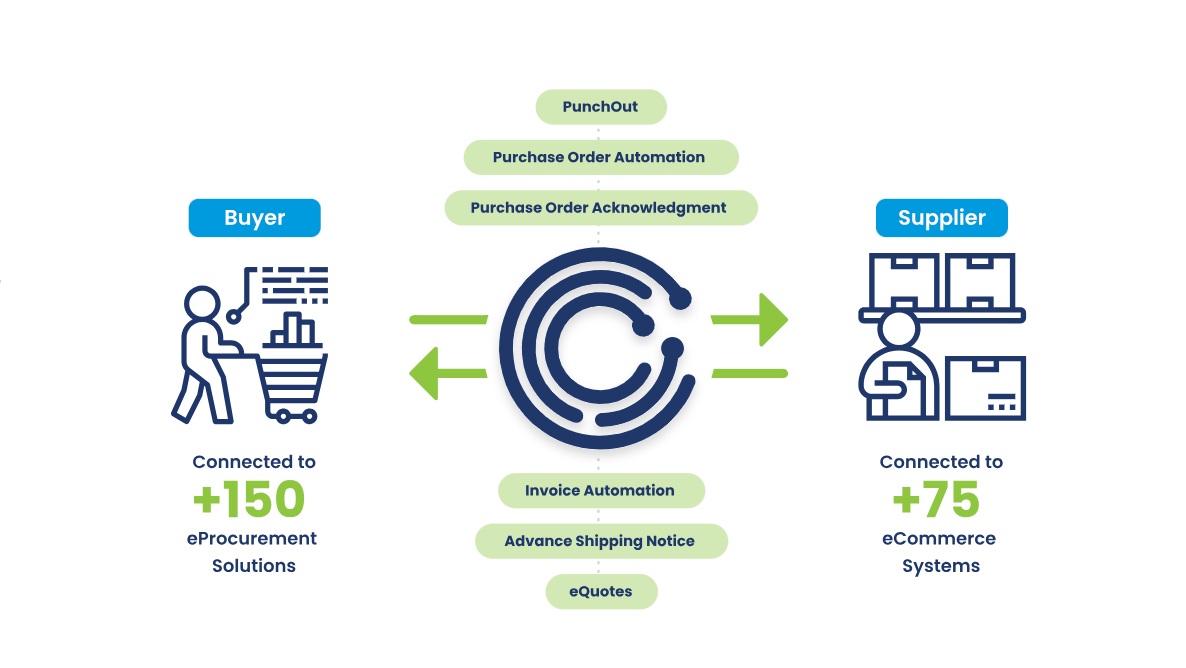Table of Contents
Purchasing from a consumer online store is easier than ever. In a few simple clicks, consumers can select a product, complete the transaction and receive a package at their door.
Despite the backend complexities of consumer online shopping, the B2C industry has perfected the seamless flow of data throughout the various systems involved with fulfilling an order.
What is connected commerce?
Connected commerce seamlessly integrates online and in-store shopping experiences, empowering customers to shop on their terms. From discovering products to making purchases and receiving goods, every step is personalized and tailored to their satisfaction.
For suppliers, this entails reverse thinking – from a single product on their data feed to offering it across various marketplaces and digital channels. While challenging, effective execution ensures the right audience sees the product, leading to conversions and customer satisfaction.
Benefits of connected commerce for B2C
Reduced costs
Integrating all sales channels reduces manual processes and cuts costs for businesses. Analyzing customer data from various channels identifies inefficiencies, streamlining operations and optimizing the supply chain, leading to further cost savings and efficiency.
New Salesforce Commerce Cloud innovations, in collaboration with Mad Mobile, empower retailers to boost revenue and margins while enhancing efficiency and reducing costs. Read more about the collaboration here.
Increased sales
Connected commerce has the capacity to boost sales through seamless and personalized shopping experiences, facilitating easier product discovery and purchase for customers. Consequently, businesses can enhance online ordering conversion rates and mitigate cart abandonment.
Enhanced loyalty
An integrated shopping experience fosters stronger customer loyalty by delivering consistent messaging, promotions, and pricing across all channels, building trust and creating an immersive shopping journey.
Recent Salesforce research reveals that a disconnected customer experience is the primary frustration for retail customers, with 79% intending to reevaluate their spending in the upcoming year. However, 65% of surveyed consumers express loyalty to companies offering personalized experiences.
Marketplaces are essential to achieving a connected commerce strategy
Connected commerce entails providing a personalized shopping journey tailored to each customer’s preferences. Brands must ensure their presence across various platforms where their target audience searches for products. Setting up an online business or your own website is just the beginning.
By being accessible across multiple channels, brands increase their chances of making a sale and delivering a next-generation shopping experience for everyone.
Retail and connected commerce
Connected commerce is undeniably becoming a permanent fixture in the online retail landscape. As customers continue to embrace both online and offline marketing and shopping experiences, businesses must adapt to meet them wherever they choose to make a purchase.
However, traditional brick-and-mortar retail is far from obsolete. Research by Shopify indicates a trend towards more brands establishing physical retail spaces to engage with customers in-person. These spaces will offer personalized appointments, immersive experiences, and utilize staff as brand ambassadors to foster meaningful connections with customers.
How connected commerce can be applied in the B2B market

Unlike its consumer counterpart, the world of B2B commerce is fragmented, and buyer and supplier systems remain largely disconnected. Processing purchase data too often relies heavily on manual handling for both sides of a transaction, which not only creates inefficiencies but is also time consuming and more prone to error.
Global companies need solutions that connect disparate systems to improve efficiency throughout the B2B buying and selling process. Connectivity between eCommerce systems and eProcurement solutions is key to achieving a seamless flow of purchasing data throughout every step of the buying process.
A Connected Commerce Strategy Requires B2B Integration
There are many steps in B2B purchasing, including authenticating into suppliers’ eCommerce sites, entering requisition orders in eProcurement solutions, sending purchase orders, acknowledging their receipt and acceptance, reconciling invoices and so on.
Each side of the transaction can be automated to some degree. Buying organizations use eProcurement solutions to facilitate data flow, promote visibility within procurement approvals and control spend. Suppliers leverage eCommerce systems and enterprise resource planning (ERP) platforms to streamline ordering, manage stock and monitor logistics. But an essential piece is missing that prevents organizations from achieving their full automation potential – interconnectivity between supplier eCommerce systems and buyer eProcurement solutions, also known as connected commerce.
In the B2B market, there are hundreds of eCommerce systems and eProcurement solutions, each with their own data protocol requirements. Understanding and integrating these systems can be a daunting task, particularly for companies who may be new to B2B commerce integration and/or may not have robust technical teams.
Some organizations may decide to develop, host and maintain custom integrations that connect eCommerce systems and eProcurement solutions. That strategy works in theory, but in practice, it is expensive to implement, needs to be maintained, and often well outside the core competence and scope of most B2B buyers’ and suppliers’ IT capabilities.
A better solution is partnering with a connected commerce specialist that leverages an Integration Platform as a Service (iPaaS) to achieve seamless connectivity. An iPaaS is a cloud integration layer that sits between buyer eProcurement solutions and supplier eCommerce systems to translate and transform purchase transaction data.
Strategies for Implementing Connected Commerce
Connected commerce works by facilitating data exchange during each stage of a B2B commerce transaction. It starts with PunchOut catalogs, which enable a buyer to access eCommerce stores and place orders within their eProcurement solution. The buyer selects an approved supplier and they are automatically transferred to and authenticated into the supplier’s eCommerce store.
The buyer interacts with the eCommerce store as they would for any other purchase: they search for, browse and select products to add to their cart. When they’ve finished shopping, instead of completing the transaction on the eCommerce site, the buyer transfers their cart data back to their eProcurement solution, which subsequently creates a requisition order. The buyer doesn’t have to manually search for approved suppliers, authenticate, or most importantly, manually enter the order into their eProcurement solution. Connected commerce, enabled via integration, facilitates the back-and-forth data transfers that makes this process possible.
With connected commerce, many tasks that would otherwise be done manually are automated – but PunchOut is just one aspect of connected commerce. Each step in a transaction can be automated, including:
- Purchase Order (PO) Automation: Once a requisition order is approved, a PO is generated automatically, eliminating the need to manually generate and key in a purchase order. Importantly, connected commerce translates a PO into the data format the supplier’s systems are expecting so it can flow electronically.
- Purchase Order Acknowledgement (POA): A POA with order and line-item data is returned to the buyer’s eProcurement solution, confirming the order has been placed.
- Advanced Shipping Notifications (ASNs): ASNs are delivered to the buyer, informing them of additional shipment and tracking information.
- Invoice Automation: Invoices are converted into a suitable data format and communicated to the buyer’s eProcurement or ERP solution.
Benefits of Connected Commerce
The benefits of connected commerce go far beyond simple automation. Consider three-way matching, a process carried out when a buyer is validating whether an invoice should be paid. It requires matching the supplier’s invoice with the purchase order and the order receipt.
Three-way matching must be carried out before an invoice is paid, but it’s time-consuming, especially if the required information is only available as a hard-copy or a PDF stored in an email inbox.
Connected commerce radically simplifies three-way matching. While many eProcurement solutions include three-way matching functionality, it is required for the invoice, PO and delivery receipt data to be present in the eProcurement solution.
An integrated system with PO Automation and Invoice Automation communicates that data, ensures the data is properly formatted and automatically flags any errors. There’s no need for labor-intensive manual data entry and the likelihood of errors is substantially reduced. Additionally, the buyer can take full advantage of their eProcurement solution’s ability to streamline and automate the matching process all in one place. Advance Shipping Notice also adds another important piece of data and can fill the void if an order receipt is missing. For suppliers, the ability to support integration enabled 3-way matching further positions them as a premiere trading partner for existing and new customers.
Connected commerce enables B2B buyers and suppliers to remove friction from the purchasing process and eliminate manual errors – all while allowing employees to focus on key value-add activities that drive the business forward.




